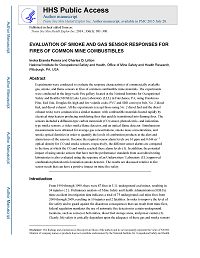Mining Publication: Evaluation of Smoke and Gas Sensor Responses for Fires of Common Mine Combustibles
Original creation date: March 2015
Experiments were conducted to evaluate the response characteristics of commercially available gas, smoke and flame sensors to fires of common combustible mine materials. The experiments were conducted in the large-scale fire gallery located at the National Institute for Occupational Safety and Health (NIOSH) Lake Lynn Laboratory in Fairchance, PA, using ponderosa pine, red oak, Douglas fir, high and low volatile coals, polyvinyl chloride (PVC) and styrene butadiene rubber (SBR) conveyor belts, No. 2 diesel fuel and diesel exhaust. All the experiments (except those using No. 2 diesel fuel and the diesel exhaust tests) were conducted in a similar manner, with combustible materials heated rapidly by electrical strip heaters, producing smoldering fires that quickly transitioned into flaming fires. The sensors included a diffusion-type carbon monoxide (CO) sensor, photoelectric- and ionization-type smoke sensors, a video smoke/flame detector and an optical flame detector. Simultaneous measurements were obtained for average gas concentrations, smoke mass concentrations and smoke optical densities in order to quantify the levels of combustion products at the alert and alarm times of the sensors. Because the required sensor alarm levels are 10 ppm and 0.044 m-1 optical density for CO and smoke sensors, respectively, the different sensor alarms are compared to the time at which the CO and smoke reached these alarm levels (Litton et al., 1991). In addition, the potential impact of using smoke sensors that have met the performance standards from accredited testing laboratories is also evaluated using the response of an Underwriters' Laboratory (UL)-approved combination photoelectric/ionization smoke detector. The results are discussed relative to fire sensor needs that can have a positive impact on mine fire safety.
Authors: I Perera, CD Litton
Peer Reviewed Journal Article - March 2015
NIOSHTIC2 Number: 20046523
Trans Soc Min Metal Explor 2015 Mar; 336:381-390
See Also
- CO Dispersion from a Coal Fire in a Mine Entry
- Comparative In-Mine Evaluation of Carbon Monoxide and Smoke Detectors
- A Comparison of Mine Fire Sensors
- Evaluation of a Signaling and Warning System for Underground Mines
- Fire Detection for Conveyor Belt Entries
- In Mine Evaluation of Discriminating Mine Fire Sensors
- In-Mine Evaluation of Smart Mine Fire Sensor
- Mine Fire Source Discrimination Using Fire Sensors and Neural Network Analysis
- Overview of Mine Fire Detection
- Rapid Detection and Suppression of Mining Equipment Cab Fires
- Content source: National Institute for Occupational Safety and Health, Mining Program


 ShareCompartir
ShareCompartir
